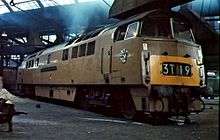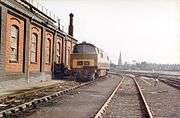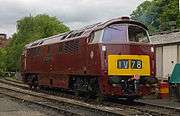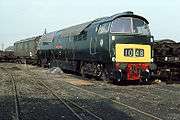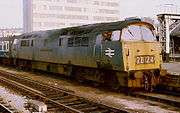British Rail Class 52
|
D1010 Western Campaigner restored to maroon livery with small yellow warning panel | |||||||||||||||||||||||||||||||||||||
| |||||||||||||||||||||||||||||||||||||
| |||||||||||||||||||||||||||||||||||||
| |||||||||||||||||||||||||||||||||||||
| |||||||||||||||||||||||||||||||||||||
British Rail (BR) assigned Class 52 to the class of 74 large Type 4 diesel-hydraulic locomotives built for the Western Region of British Railways between 1961 and 1964. All were given two-word names, the first word being "Western" and thus the type became known as Westerns.
Historical context
When switching to diesel traction as part of the Modernisation Plan of the 1950s, BR designed, and commissioned designs for, a large number of locomotive types. At this time (and arguably right up until Sectorisation in 1982), BR's regions had a high degree of autonomy, which extended as far as classes of locomotives ordered and even the design criteria for those locomotives. Whilst almost all other diesel locomotives were diesel-electric, the Western Region employed a policy of using diesel-hydraulic traction, originally commissioning three classes of main line locomotives: a type 2 and two type 4s (later designations class 22, class 41 and class 42). With pressure to increase the speed of the transition from steam to diesel, volume orders for the class 22 and class 42 followed in 1957, a mere two years after the original orders and well before any idea of performance or reliability could be gained. At the same time it was realised that all the existing orders (diesel-electric and diesel-hydraulic) were for types 1, 2 and 4; thus orders were placed for 101 Type-3 diesel-hydraulics (later Class 35). However the increasing demands for more powerful locomotives prompted a further order, in 1961, for 74 diesel-hydraulics of 2,700 hp (2,000 kW); so when the first locomotive was outshopped from Swindon Works in December 1961, less than a year after the order was placed, the Westerns were born.
The theoretical advantage of diesel-hydraulic was simple: it resulted in a lighter locomotive than equivalent diesel-electric transmission. This provided better power/weight ratio and decreased track wear. Unfortunately, it had two key disadvantages:
- The technology was proven in continental Europe, particularly Germany, but was new to the UK. At the time, it was considered politically unacceptable for the UK government to order railway rolling stock from foreign companies, especially German companies so soon after the Second World War. This resulted in most of the engines and transmissions being manufactured in the United kingdom under licence from the German manufacturers.[1]
- The most robust hydraulic transmissions were only capable of handling engines with power output of around 1500 hp (1120 kW); to build a more powerful locomotive would involve two diesel engines and two transmissions.
Experience showed that the Bristol-Siddeley-Maybach engines were superior to those made by NBL-MAN and although the use of twin engines in the same locomotive was new, the process did not produce any insurmountable problems. In the end the diesel-hydraulic experiment foundered on low fleet numbers, poor maintenance conditions and design issues; not on its German heritage or development of a novel configuration. BR's Swindon Works maintained all the diesel hydraulic locomotives and their early demise resulted in a much reduced workload and hastened its eventual closure in 1986.
The Western

With the Hymeks and Warships already in service but proving underpowered for top-link services, BR Western Region needed a high-powered locomotive for these trains – the Western therefore needed two diesel engines to achieve the required power output. In keeping with their policy, a new locomotive with a hydraulic transmission was envisaged. Experience had shown that the Maybach engines in the Hymeks were superior to the MAN engines used in the Warships, particularly in power output. Also Maybach were able to offer their 12 MD engines rated at 1,350 bhp (1,010 kW) allied to a Voith transmission; a Mekydro transmission designed to handle such power could not be fitted into the British loading gauge.
Prototypes sited the engines behind the driving cabs but drivers found this too noisy; moving the engines centrally meant making the locomotive heavier, removing some of the design's advantage. In production use, the dual-engine arrangement turned out to have some advantages: in particular, the Westerns were able to continue operating with a single engine running in situations where more conventional single-engine designs would require rescue by another locomotive. This valuable property was intentionally duplicated in the later High Speed Trains and was one reason for them having two power cars.
The most serious continual problem with the class was the design fault mismatch between the Maybach MD655 engines and the Voith L630rV three speed hydraulic transmissions. The top gear ratio in the transmission was too high for the torque characteristics of the engine: the result was that a single locomotive could struggle to reach its claimed 90 mph (140 km/h) top speed in the absence of down grades, more so when work-weary and due for overhaul. These factors, combined with the 'Devon banks' (a major part of their running grounds) deleterious effect on tired engines, all conspired against the Westerns continuing in top-line service; their replacement by Class 50s and High Speed Trains provided the speed and comfort increases the Western Region sought. Towards the end, the Westerns were all allocated to Laira (Plymouth).
Competition and comfort
Whilst the design was largely successful the working life of the class was relatively short. It was a non-standard design adding greatly to its maintenance costs while the national British Rail policy was also moving away from diesel-hydraulics. When the Westerns were introduced in 1962 the Western Region had 226 diesel-hydraulics and 10 diesel-electrics (excluding shunters); by 1966 the numbers were 345 and 269 respectively. As a result, the early 1970s saw the decision taken to retire all the diesel-hydraulic types. Class 46 and Class 47 took over passenger and heavy freight while Class 25 covered the lighter duties. Following completion of the electrification of the West Coast Mainline throughout from London to Glasgow, the Class 50s were allocated to the Western Region, the introduction of High Speed Trains 3 years later was the final nail in the coffin for the Class 52 Westerns.
In 1968–69 the Westerns received train air brake equipment in addition to their vacuum exhausters, thus significantly extending their working lives, unlike the similar but lower-powered, Warship class, although four of the class (D1017-D1020) did not receive dual brakes with these locomotives being among the first withdrawals. The vacuum brake equipment was retained and to fit the additional equipment, it was necessary to remove one of the fuel tanks.[2] However, as with the Warships, it proved impossible to equip them with electric train heating (ETH, or head-end power in US terminology). The Western Region faced particularly stiff competition for its prime inter-city services in the mid to late 1970s from the M4 motorway and it was generally felt within BR that a significant speed and comfort increase on the prime Paddington-Bristol route were necessary. The lack of ETH meant the Westerns could not power the newly introduced air-conditioned BR Mark 2d/e/f coaches – a shortcoming that classes 47 and 50, equipped with ETH (the latter from new), did not share.[3]
Performance
The highest recorded speed with a Western that O. S. Nock was aware of was 102 mph when D1068 hauled 9 coaches (305 tons gross) down 1 in 1320 (i.e. virtually level) at Southall. The train averaged exactly 100 mph for 12.8 miles between Slough and Ealing whilst hauling a service from Reading to Paddington.[4] An unverified eyewitness account by a BR secondman (Drivers assistant) stated that 110 mph had been achieved when his driver drove a Western between Reading and Westbury. He experienced the loco shaking from side to side as 110 mph was indicated on the speedometer.
However, when it came to drawbar horsepower the Westerns in some respects were less capable than the equivalent diesel electric locos. Nock states "whilst the Westerns took their rightful place as fast and powerful locomotives it became evident that they were showing the same deficiency in actual power put forth at the drawbar as the [diesel hydraulic] Warships had done. The highest output that came to my notice was a sustained 85 mph hauling 560 tons descending 1 in 1320, which equates to 1500 edhp (equivalent drawbar horsepower)".[5] This is 56% of power at the flywheel, whereas for a diesel electric one would normally expect a figure of 75 to 80%. A similar result was obtained when Clough & Beckett[6] compared the performance of type 4 diesel locomotives (Classes 45/46/47/50/52) hauling trains up the ascent to Whiteball summit. They deliberately chose data to show each class in their best light and included a Western run which produced 1775 edhp but they still concluded that "without doubt the Westerns get the wooden spoon certainly not what one would expect from units of 2700 bhp". The best performer was the Class 50, a 2700 hp diesel electric locomotive, on one run this achieved 2115 edhp.
Despite this apparent limitation, the BR Western Region load-limit book gave the same 550ton loading figure for both the Class 52 and Class 47 diesels over the South Devon banks between Newton Abbot and Plymouth. The reason for this is that, while the diesel-electric classes could produce high maximum tractive effort for limited periods, diesel hydraulics could produce significantly higher continuous tractive effort.[1]
Names and numbers

The Class 52s were never renumbered into their TOPS number series (52 xxx) and they became the last class of locomotives on BR not to carry a TOPS number. This is primarily due to them being adorned with Great Western style cast number plates, as opposed to the adhesive number transfers used on most other types. While the first Western was under construction, proposals for livery and names were prepared by the BR design panel. The D1000 series locomotives were to be named after famous West of England place names; the illustration from the portfolio shows D1000 bearing the name Cheddar Gorge. This trend was not followed in production, however and the Westerns were named with general heraldic and regimental terms prefixed with the word "Western" as per the following table:
Of the 74 locos built only 7 have survived to preservation.
| Number | Name | Builder | Status | Disposal |
|---|---|---|---|---|
| D1000 | Western Enterprise | BR Swindon 20.12.61 | Scrapped | 31.07.74 BREL Swindon |
| D1001 | Western Pathfinder | BR Swindon 12.02.62 | Scrapped | 08.77 BREL Swindon (see also #Incidents) |
| D1002 | Western Explorer | BR Swindon 19.03.62 | Scrapped | 12.06.74 BREL Swindon |
| D1003 | Western Pioneer | BR Swindon 14.04.62 | Scrapped | 08.77 BREL Swindon |
| D1004 | Western Crusader | BR Swindon 12.05.62 | Scrapped | 19.09.74 BREL Swindon |
| D1005 | Western Venturer | BR Swindon 18.06.62 | Scrapped | 17.06.77 BREL Swindon |
| D1006 | Western Stalwart | BR Swindon 06.07.62 | Scrapped | 24.03.77 BREL Swindon |
| D1007 | Western Talisman | BR Swindon 01.08.62 | Scrapped | 24.02.75 BREL Swindon (see also #Incidents) |
| D1008 | Western Harrier | BR Swindon 04.09.62 | Scrapped | 10.10.75 BREL Swindon |
| D1009 | Western Invader | BR Swindon 24.09.62 | Scrapped | 11.78 BREL Swindon |
| D1010 | Western Campaigner | BR Swindon 15.10.62 | Preserved | Withdrawn 28.02.77. Owned by the Diesel & Electric Preservation Group, West Somerset Railway |
| D1011 | Western Thunderer | BR Swindon 27.10.62 | Scrapped | 12.78 BREL Swindon |
| D1012 | Western Firebrand | BR Swindon 17.11.62 | Scrapped | 04.79 BREL Swindon |
| D1013 | Western Ranger | BR Swindon 13.12.62 | Preserved | Withdrawn 28.02.77. Owned by Western Locomotive Association, Severn Valley Railway |
| D1014 | Western Leviathan | BR Swindon 24.12.62 | Scrapped | 13.02.75 BREL Swindon |
| D1015 | Western Champion | BR Swindon 21.01.63 | Preserved | Withdrawn 13.12.76. Owned by Diesel Traction Group, Severn Valley Railway. It is also the only Western that is certified for mainline use. |
| D1016 | Western Gladiator | BR Swindon 16.02.63 | Scrapped | 08.77 BREL Swindon |
| D1017 | Western Warrior | BR Swindon 15.03.63 | Scrapped | 12.03.75 BREL Swindon |
| D1018 | Western Buccaneer | BR Swindon 02.04.63 | Scrapped | 20.03.74 BREL Swindon, the first "Western" to be scrapped. |
| D1019 | Western Challenger | BR Swindon 02.05.63 | Scrapped | 03.10.74 BREL Swindon |
| D1020 | Western Hero | BR Swindon 21.05.63 | Scrapped | 17.04.74 BREL Swindon |
| D1021 | Western Cavalier | BR Swindon 17.06.63 | Scrapped | 02.79 BREL Swindon |
| D1022 | Western Sentinel | BR Swindon 16.07.63 | Scrapped | 12.78 BREL Swindon |
| D1023 | Western Fusilier | BR Swindon 23.09.63 | Preserved | Withdrawn 28.02.77. Part of the national collection, NRM Was the last Western to receive a general overhaul at Swindon works, in February 1973 |
| D1024 | Western Huntsman | BR Swindon 01.10.63 | Scrapped | 14.08.74 BREL Swindon |
| D1025 | Western Guardsman | BR Swindon 01.11.63 | Scrapped | 01.79 BREL Swindon |
| D1026 | Western Centurion | BR Swindon 24.12.63 | Scrapped | 06.08.76 BREL Swindon |
| D1027 | Western Lancer | BR Swindon 28.01.64 | Scrapped | 10.06.76 BREL Swindon |
| D1028 | Western Hussar | BR Swindon 25.02.64 | Scrapped | 06.79 BREL Swindon, the penultimate "Western" to be scrapped. |
| D1029 | Western Legionnaire | BR Swindon 20.04.64 | Scrapped | 29.05.75 BREL Swindon |
| D1030 | Western Musketeer | BR Crewe 05.12.63 | Scrapped | 22.09.76 BREL Swindon |
| D1031 | Western Rifleman | BR Crewe 20.12.63 | Scrapped | 06.10.76 BREL Swindon |
| D1032 | Western Marksman | BR Crewe 31.12.63 | Scrapped | 05.12.74 BREL Swindon |
| D1033 | Western Trooper | BR Crewe 17.01.64 | Scrapped | 04.79 BREL Swindon |
| D1034 | Western Dragoon | BR Crewe 15.04.64 | Scrapped | 20.05.77 BREL Swindon |
| D1035 | Western Yeoman | BR Crewe 17.07.62 | Scrapped | 30.09.76 BREL Swindon |
| D1036 | Western Emperor | BR Crewe 29.08.62 | Scrapped | 24.02.77 BREL Swindon |
| D1037 | Western Empress | BR Crewe 31.08.62 | Scrapped | 16.02.77 BREL Swindon |
| D1038 | Western Sovereign | BR Crewe 07.09.62 | Scrapped | 20.11.74 BREL Swindon |
| D1039 | Western King | BR Crewe 07.09.62 | Scrapped | 05.09.74 BREL Swindon |
| D1040 | Western Queen | BR Crewe 20.09.62 | Scrapped | 11.08.76 BREL Swindon (see also #Incidents) |
| D1041 | Western Prince | BR Crewe 10.10.62 | Preserved | Withdrawn 23.02.77. Owned by Diesel Group of the East Lancashire Railway |
| D1042 | Western Princess | BR Crewe 19.10.62 | Scrapped | 18.05.74 BREL Swindon |
| D1043 | Western Duke | BR Crewe 26.10.62 | Scrapped | 10.02.77 BREL Swindon |
| D1044 | Western Duchess | BR Crewe 12.11.62 | Scrapped | 10.09.75 BREL Swindon |
| D1045 | Western Viscount | BR Crewe 16.11.62 | Scrapped | 21.08.75 BREL Swindon |
| D1046 | Western Marquis | BR Crewe 24.12.62 | Scrapped | 10.11.76 BREL Swindon |
| D1047 | Western Lord | BR Crewe 04.02.63 | Scrapped | 09.09.76 BREL Swindon |
| D1048 | Western Lady | BR Crewe 15.12.62 | Preserved | Withdrawn 28.02.77. Owned privately, operated by the Midland Diesel Group, Midland Railway – Butterley |
| D1049 | Western Monarch | BR Crewe 14.12.62 | Scrapped | 03.02.77 BREL Swindon |
| D1050 | Western Ruler | BR Crewe 01.01.63 | Scrapped | 08.04.76 BREL Swindon |
| D1051 | Western Ambassador | BR Crewe 21.01.63 | Scrapped | 08.77 BREL Swindon |
| D1052 | Western Viceroy | BR Crewe 04.02.63 | Scrapped | 22.04.76 BREL Swindon |
| D1053 | Western Patriarch | BR Crewe 11.02.63 | Scrapped | 08.77 BREL Swindon |
| D1054 | Western Governor | BR Crewe 02.03.63 | Scrapped | 05.77 BREL Swindon |
| D1055 | Western Advocate | BR Crewe 02.03.63 | Scrapped | 16.06.76 BREL Swindon (see also #Incidents) |
| D1056 | Western Sultan | BR Crewe 08.03.63 | Scrapped | 05.79 BREL Swindon |
| D1057 | Western Chieftain | BR Crewe 06.04.63 | Scrapped | 06.77 BREL Swindon |
| D1058 | Western Nobleman | BR Crewe 25.03.63 | Scrapped | 06.79 BREL Swindon, the last "Western" to be scrapped. |
| D1059 | Western Empire | BR Crewe 06.04.63 | Scrapped | 21.07.76 BREL Swindon |
| D1060 | Western Dominion | BR Crewe 11.04.63 | Scrapped | 03.07.74 BREL Swindon |
| D1061 | Western Envoy | BR Crewe 19.04.63 | Scrapped | 07.08.75 BREL Swindon |
| D1062 | Western Courier | BR Crewe 06.05.63 | Preserved | Withdrawn 22.08.74. Owned by Western Locomotive Association, Severn Valley Railway[7] |
| D1063 | Western Monitor | BR Crewe 17.05.63 | Scrapped | 08.77 BREL Swindon |
| D1064 | Western Regent | BR Crewe 24.05.63 | Scrapped | 06.77 BREL Swindon |
| D1065 | Western Consort | BR Crewe 18.06.63 | Scrapped | 08.77 BREL Swindon |
| D1066 | Western Prefect | BR Crewe 14.06.63 | Scrapped | 21.05.75 BREL Swindon |
| D1067 | Western Druid | BR Crewe 18.07.63 | Scrapped | 16.09.76 BREL Swindon (see also #Incidents) |
| D1068 | Western Reliance | BR Crewe 12.07.63 | Scrapped | 08.77 BREL Swindon |
| D1069 | Western Vanguard | BR Crewe 21.10.63 | Scrapped | 03.02.77 BREL Swindon |
| D1070 | Western Gauntlet | BR Crewe 28.10.63 | Scrapped | 05.79 BREL Swindon |
| D1071 | Western Renown | BR Crewe 07.11.63 | Scrapped | 11.78 BREL Swindon (see also #Incidents) |
| D1072 | Western Glory | BR Crewe 07.11.63 | Scrapped | 04.04.77 BREL Swindon |
| D1073 | Western Bulwark | BR Crewe 03.12.63 | Scrapped | 01.08.75 BREL Swindon |
D1029 was originally named Western Legionaire [sic], but renamed Western Legionnaire in 1969, the nameplate being cut to allow the additional letter to be inserted.[8]
Although designated Class 52 under the TOPS scheme, no Western ever carried its "52 0xx" TOPS number. As withdrawal was already planned when the TOPS numbering scheme was introduced and because of the cast number plates, it was not considered cost effective to renumber the locomotives. Some class members did run with the "D" of their number painted over – TOPS classification removed the need for locomotives to indicate their energy type in the running number (D = Diesel, E = Electric), rather grouping locomotives into relevant class number ranges based on power output and energy type combined (this convention has become somewhat blurred in recent years), 01 to 69 being diesel, 70 to 97 electric, and 98 all steam types.
When the display of destination headcodes/reporting numbers on the front of trains was dropped in 1976, the instruction was given for them all to be set to "0000". On many Westerns, the headcode was set to display the loco's number in contravention of this directive and most surviving members of the class ran like this until they were scrapped. If used for routeing, such reporting numbers would be interpreted as a passenger express terminating on the Southern Region.[9]
Liveries
Early liveries
When the initial batch of Westerns was being built in 1961-2, British Rail was considering a new unified corporate colour scheme but had not yet made a final decision on what it would be. As a result, some of the early locomotives were painted in experimental liveries: D1000 was rolled out of Swindon Works in November 1961 painted in Desert Sand.[10] Initially the numbers, borne on the left hand cab when viewed from the side, were painted in white but soon individual numbers and letters, looking like they were cast but apparently made of wood, were fitted. This was in turn replaced by the final design of cast nameplate and numberplate; metal with a black background. This livery was later altered by the addition of a small yellow warning panel and black roof. After this, D1001 was delivered in all over maroon livery with yellow buffer beams and D1002-D1004 in all over green and small yellow warning panel.[10] The remaining deliveries were all in maroon, with small yellow warning panels after D1010 and D1043 of the Crewe built locomotives. Exceptions to this were the initial Crewe-built batch D1035-D1038 which were in green with red backgrounds to the nameplates and D1015, outshopped in the experimental "golden ochre" livery with small yellow warning panels.[10] On one end of D1015, the yellow panel was embellished by the addition of a yellow band which extended sideways from each of the top corners and round and onto the cabside for a short distance, resembling a T shape.
Corporate scheme
After the adoption of Rail Blue with full yellow ends in 1966 (D1048 was the first of the class painted in this livery in 1966), for some unexplained reason a small batch of locos (D1017, D1030, D1036, D1037, D1043, D1047 and D1057) received this variant married to small yellow warning panels, D1030 even carried red buffer beams for a short while. All other repaints were with full yellow ends which extended from the body line above the buffer beam up to the base of the window frames, along the sill of the cab-side windows onto the vertical end reveal. The valance above the cab windows on the front was also painted yellow, leaving the window frames in their base aluminium. The drive to repaint the locomotives in Rail Blue was outstripped by the safety directive dictating full yellow ends for all powered vehicles and some locomotives ran for a time with their original maroon bodies and full yellow ends.
The last loco to be repainted into Rail Blue was D1046, outshopped from Swindon in May 1971. Some early photographs of the blue livery give it a more metallic shade which is even more evident on the locos with small yellow panels. This however is possibly a photographic anomaly with colour film or due to printing techniques.
It is commonly accepted amongst Western enthusiasts in recent years that none of the class or any other British Rail locomotive of the period were ever painted with a metallic paint. However, several publications refer to initial painting in blue as being "chromatic blue" and published images do show a metallic sheen and lighter shade of blue than the standard Rail Blue.[11]
|
Incidents
- 15 August 1963. Knowle and Dorridge rail crash. No. 1040 Western Queen collided with a freight train, crushing the cab killing the three train crew. The locomotive was repaired and returned to service.[12]
- 11 January 1967 St Annes Bristol rail crash. No. 1071 Western Renown in charge of the diverted 12:00 Paddington to Swansea collided with the rear of the 11:45 Paddington to Bristol hauled by No. 1067 Western Druid. The collision resulted in very severe damage being caused to the leading cab of locomotive No.1071, but the three men in the cab escaped injury by moving into the centre of the locomotive. Nineteen passengers required first aid or medical treatment but there were no fatalities or serious injuries. The locomotive was repaired and returned to service.[13][14][15]
- 19 December 1973. Ealing rail crash. No. 1007 Western Talisman derailed while hauling an express passenger train, after an unlocked battery box door fell open, broke off and changed points under the locomotive. Ten people died.[16]
- 3 January 1976 (Worcester Tunnel). No. 1055 Western Advocate crashed into a stationary parcels train killing the Driver and Guard of the Western.[17]
- 4 October 1976 (Stoke Canon, Exeter). No. 1001 Western Pathfinder was working an overnight parcels train from London Paddington to Penzance when the train was in collision with a workers van at a level crossing. One workman in the van died in the accident. The locomotive was removed to Exeter St Davids depot. Despite sustaining relatively minor damage, the imminent demise of the entire fleet of Class 52's resulted in condemnation of the locomotive. Up to this point, Western Pathfinder had been a serious contender for preservation.
See also
- Krauss-Maffei ML 2200 C'C', RENFE Class 340, contemporary twin engined, twin transmission C'C' diesel hydraulic locomotives
- Voith Maxima, modern (2000s) single engined, single transmission high power diesel hydraulic locomotive
References
- 1 2 Clough, David N (2011). Hydraulic vs Electric; The battle for the BR diesel fleet. Hersham, Surrey: Ian Allan. ISBN 978 0 7110 3550 8.
- ↑ Reed 1978, pp. 70–71
- ↑ Heaps, Chris (1988). BR Diary 1968–1977. Ian Allan. p. 67. ISBN 0 7110 1611 9.
- ↑ Farr, K.S. (May 1976). Slater, J.N., ed. "'Western' Sunset". Railway Magazine. Vol. 122 no. 901. London: IPC Transport Press. pp. 225–226.
- ↑ Nock, O.S. (1985). British Locomotives of the 20th Century: Volume 3 1960-the present day. London: Guild Publishing/Book Club Associates. p. 59. CN9613.
- ↑ BR Motive Power Performance, p. 122
- ↑ "Western Courier completed". The Railway Magazine. Vol. 154 no. 1,290. October 2008. p. 81. ISSN 0033-8923.
- ↑ Walker, M (September 2002). "Loco profile of the Westerns.". The Marlow Donkey (101): 8–10.
- ↑ Bailey, M.R. (February 1968). British Rail Headcodes (5th ed.). Shepperton: Ian Allan. pp. 5–7. ISBN 0-7110-0000-X. 458 GEX 268.
- 1 2 3 Vaughan, John (1977). Western Diesels in Camera. Shepperton: Ian Allan. ISBN 0-7110-0831-0.
- ↑ Judge, Colin (1977). The Power of the Westerns. Oxford: OPC. pp. Plate 44. ISBN 0-902888-98-6.
- ↑ McMullen, D (1964). "Report on the Collision that occurred on 15th August 1963 at Knowle and Dorridge" (PDF). Railways Archive. HMSO. Retrieved 30 January 2015.
- ↑ Pages 1 to 7. Railway company: Western Region. Report on the Collision that occurred...
- ↑ Report on the Collision that occurred on 11th January 1967 at St. Anne's Park, Bristol in the Western Region British Railways
- ↑ Image details - Rail collision St Anne's Park, near Bristol
- ↑ "Official accident report" (PDF). HMSO, reproduced at The Railways Archive. Retrieved 16 September 2009.
- ↑ King, A.G.B. (28 September 1977). "Report on the Collision that occurred on 3rd January 1976 at Worcester Tunnel Junction" (PDF). Retrieved 7 September 2010.
Sources
- Ford, H L (1973). Diesels on Cornwall's main line. Truro: D Bradford Barton.
- Hall, Stanley (2006). Railway Milestones and Millstones. Hersham: Ian Allan Publishing. pp. 125–130. ISBN 0-7110-3110-X.
- Kichenside, Geoffrey (1975). Farewell to the Westerns. Newton Abbot: David & Charles. ISBN 0-7153-7069-3.
- Preedy, Norman E; Gillham, G F (1974). WR Diesel Hydraulics. Truro: D Bradford Barton.
- Reed, Brian (1978) [1975]. Diesel-Hydraulic Locomotives of the Western Region. Newton Abbot: David & Charles. ISBN 0-7153-6769-2.
- Taylor, Ken. A Decade After. Walsall: Midland Railfans.
- Till, J O (1977). Western Stock List. Camberley: Steam & Diesel Publications.
- Watts, Peter (1977). Western Memories. Gloucester: Peter Watts. ISBN 0-906025-00-1.
Further reading
- Birt, David (1988). The Class 52s: A Tribute to the Westerns. OPC. ISBN 9780860934240. OCLC 315783582.
- Chapman, Chris (2002). Western Glory. Waterfront. ISBN 9780946184996. OCLC 786126155.
- Clarke, David; Jennison, John (2007). Diesels in Depth: Westerns. Ian Allan. ISBN 9780711032507. OCLC 159634206.
- Clough, David N. (2011). Hydraulic vs Electric: The battle for the BR diesel fleet. Ian Allan. ISBN 978-0-7110-3550-8.
- Cross, David (2012). Fifty Years of the Westerns. Ian Allan. ISBN 9780711036581. OCLC 794814820.
- Curtis, Adrian (2001). Western Liveries. A & C Services. ISBN 9780954021313. OCLC 49299854.
- Curtis, Adrian N. (2011–2012). Westerns Vols 1/2/3. Western Legacy Publications.
- Curtis, Adrian N. (2002). Western Dawn. A&C Services.
- Curtis, Adrian N. (2000). Cast of Thousands. A&C Services.
- Curtis, Adrian N. (2012). Final Salute '77. Western Legacy Publications.
- Curtis, Adrian N. (2012). Spirit of '76. Western Legacy Publications.
- Curtis, Adrian N. (2012). Indian Summer '75. Western Legacy Publications.
- Curtis, Adrian N. (2012). Tracks of my Years. Western Legacy Publications.
- Curtis, Adrian N. (2012). Teenage Lament '74. Western Legacy Publications.
- Curtis, Adrian N. (2010–2012). Western Power. Western Legacy Publications. Missing or empty
|title=(help) - Curtis, Adrian N. (1996–2012). Classic Diesels & Electrics. Western Legacy Publications. Missing or empty
|title=(help) - Curtis, Adrian N. (2010–2012). Diesel Hydraulics Illustrated. Western Legacy Publications.
- Dowle, Stephen (2015). Class 52 Westerns: The Twilight Years. Amberley Publishing. ISBN 9781445648989. OCLC 919481086.
- Ford, H.L.; Preedy, Norman E. (1976). The Westerns: British Rail Class 52 Diesel Hydraulics. Bradford Barton. ISBN 9780851532738. OCLC 2797567.
- Huntriss, Derek (2003). The Heyday of the Westerns. Ian Allan. ISBN 9780711029811. OCLC 52530865.
- McManus, Michael. Ultimate Allocations, British Railways Locomotives 1948 – 1968. Wirral. Michael McManus.
- Nicholas, D.; Montgomery, S. (2005). Profile of the Westerns. Ian Allan. ISBN 9780860931164. OCLC 10723140.
- Preedy, Norman (2015). British Railway Diesel Memories: The Western Class 52s. Book Law Publications. ISBN 9781909625457.
- Preedy, Norman E. (1977). Book of the Westerns. Peter Watts. ISBN 9780906025031. OCLC 650233739.
- "Where 'Westerns' went". Rail Enthusiast. EMAP National Publications. February–March 1982. p. 54. ISSN 0262-561X. OCLC 49957965.
- Kelly, Peter (January 1983). "Maybach music!". Rail Enthusiast. EMAP National Publications. pp. 14–17. ISSN 0262-561X. OCLC 49957965.
- "Western Lady". Rail Enthusiast. EMAP National Publications. November 1983. p. 21. ISSN 0262-561X. OCLC 49957965.
External links
| Wikimedia Commons has media related to British Rail Class 52. |

